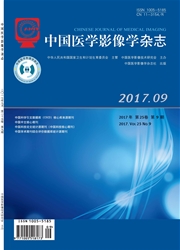

 中文摘要:
中文摘要:
目的 探讨利用MRI原始数据集构建在体胎儿体表数字化三维模型的方法及意义。资料与方法 选择3例有强烈自然分娩愿望并自愿在南方医科大学南方医院行下腹盆腔MRI检查的足月孕妇,用二维稳态快速采集成像序列进行扫描,采集其原始Dicom数据集并导入Mimics 10.01软件中行胎儿数字化三维重建。结果 在二维图像上,胎儿体表组织呈低信号,羊水及肺、膀胱、脑脊液等含水多的器官呈高信号,胎盘及子宫壁呈中等偏低信号,胎儿体表边界清晰;成功构建出在体胎儿体表的数字化三维模型,该模型可以清晰、立体、直观地显示胎儿整体体表解剖结构,并可以从任意角度观察胎儿的形态及胎儿宫内姿势。结论 基于MRI数据集可以构建在体胎儿体表数字化三维模型,具有立体感强、视野大、可任意角度观察等优点,为后期胎儿的形态学分析、生物测量及生长发育评估提供新的方法。
 英文摘要:
英文摘要:
Purpose To explore the significance of three-dimensional reconstruction of fetus based on MRI scan data. Materials and Methods Three woman (more than 39 weeks' gestation) with a strong wish to have natural childbirth and voluntary to take the examination in Nanfang Hospital of Southern Medical University were recruited in the study. Mimics 10.01 software was used to do three-dimensional reconstruction. Results The fetal surface tissue showed low signal on the two-dimensional images, and amniotic fluid and lung, bladder, cerebrospinal fluid showed high signal. The placenta and uterine wall showed moderate to low signal. Those contributed to the clear boundary between fetal surface and other tissue surround. The three-dimensional fetus models were reconstructed successfully, which clearly demonstrated the main surface features and spatial position of the fetus. The fetal morphology and fetal position could be viewed in various directions. Conclusion Fetus surface can be reconstructed into three-dimensional model based on MRI data set, which has advantage of large visual field and can be observed at arbitrary angle. It provides a new method for morphological analysis and prenatal evaluation for fetal development and growth.
 同期刊论文项目
同期刊论文项目
 同项目期刊论文
同项目期刊论文
 期刊信息
期刊信息
